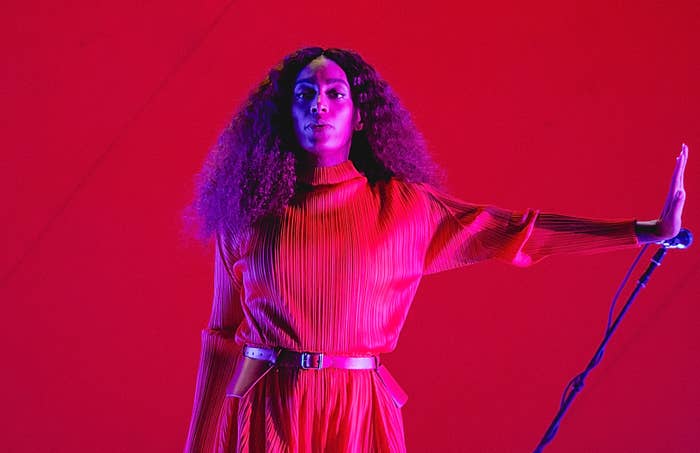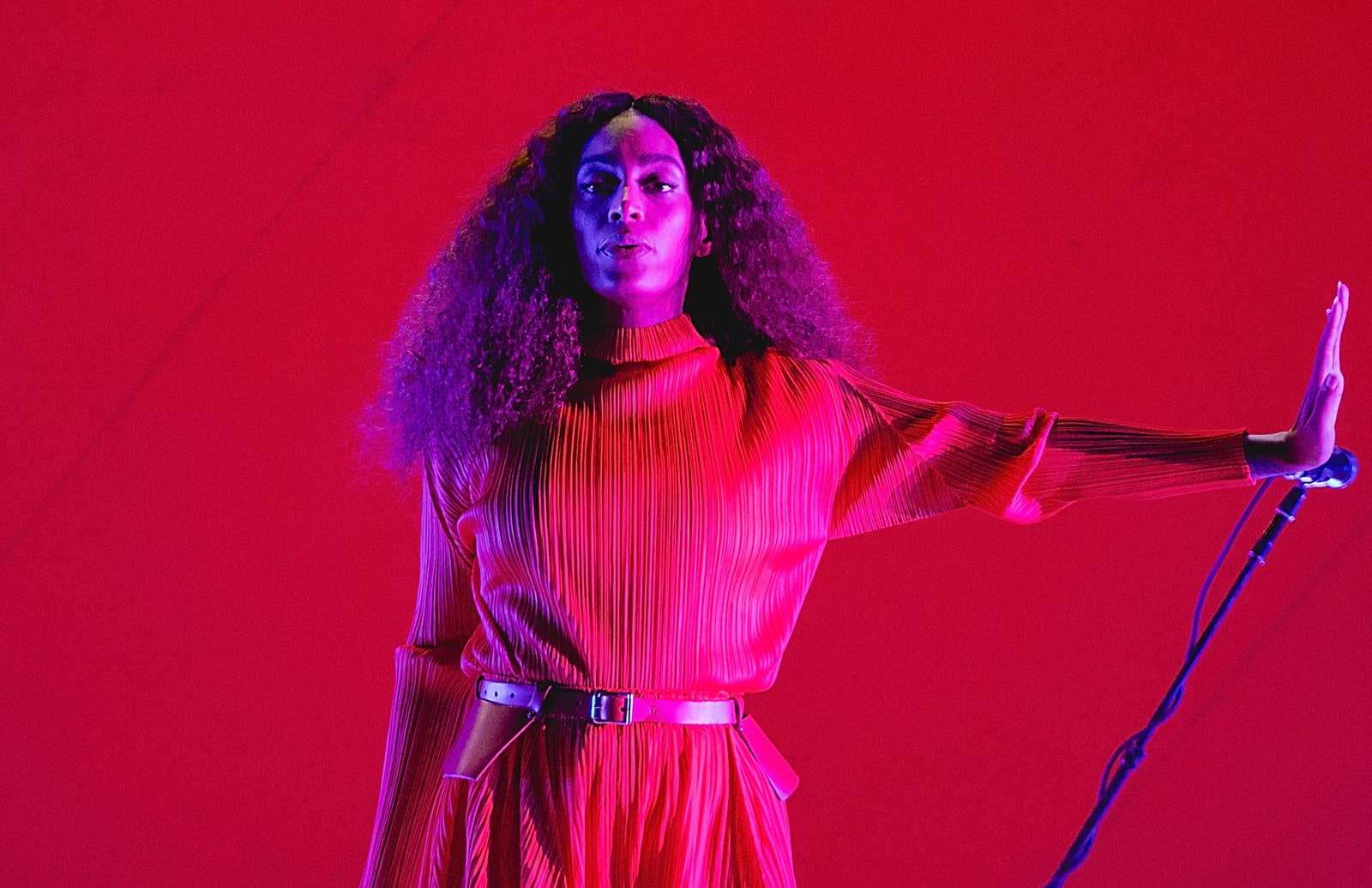
Sunday Funday in Houston's Third Ward is a ritual. Brown bodies radiate off the sun with a special glow. People smile, sip mimosas out of fish bowls, and open up about their dreams and vulnerabilities.
Before I even heard Solange speak on the importance of the Third Ward in reference to her new album When I Get Home, I listened to “Almeda” while riding down the very street that bears its name. And it feels like riding on a cloud while having a black ass therapist who keeps you near and dear.
The epicenter of blackness in Houston’s Third Ward exists along a small stretch of businesses; famous faces exchange glimpses for the sake for brunch, turkey legs, and impromptu car shows. It’s where Solange called home—where a group chat and finsta profiles kept her down and sane.
During an intimate sit-down in Houston on Sunday evening, Solange played her When I Get Home film and explained that being back in Third Ward was as a crucial part of the album’s creative process.
“With A Seat At The Table, I had so much to say. With this album, I had so much to feel.” - Solange
“There were a lot of things that were happening with my body and my spirit,” she said. “When you go through something like that, you yearn for things that remain same. And I know, any time in my life, I can come back home to Houston, Texas—to Third Ward. So I quietly rented a home in Third Ward off Wichita and started to write new music, but more than anything reflect on my journey. There’s nothing like coming home, getting off the plane, getting in the car, listening to 97.9 The Box. Nothing like it.”
Solange began writing new music in that Third Ward house, chronicling her journey. The things that she once thought were mundane now inspired her. It’s why the album and its accompanying visual features pieces of Texas throughout. The project is shaped by the renaissance of young black people creating experimental work, such as Dallas native Terrance Nance’s work on Random Acts Of Flyness, Robert Pruit, Autumn Knight, and ZolarMoon (the woman who is the face of the futuristic “Stay Flo” scene in the film).
The song titles are allusions to Third Ward markers and Southside monuments, and the album features spoken word from the likes of Scarface, Debbie Allen, and Phylicia Rashad. When I Get Home isn’t structured around one woman who acts as the voice for millions, like 2016’s A Seat At The Table. Instead, it’s the inverse; many help establish and create a singular voice that is even louder than she was alone.
“The scary part was not knowing how to get there, but when you have a clear roadmap to get there, that’s when things start to feel less scary,” Solange told the Houston audience on Sunday. “I didn’t feel scared on February 28th. I felt so sure. I had to make this for me. I had so much to give on my last project while also needing to heal and work through these things. But that was for everybody. Home is for me. And I needed that moment.”
Surrounded by family (Mama Tina aka Tina Knowles-Lawson sat in the front row, same for Solo’s husband Alan Ferguson) as well as collaborators (Metro Boomin, Devin the Dude, Cassie, Abra) and stars (Bun B, Letitia Wright), Solange held center court. She spoke for thirty minutes inside the SHAPE Community Center, one of the Third Ward’s beacons in regards to outreach, discussing the album and her thoughts behind it.
“I started writing this album while on tour,” she said. “There were a lot of moments where we worked on arrangements during A Seat At The Table that would have a little more nuance, more frequency, and more experimentation with sound.”
The freedom of experimentation permeates throughout. Solange heavily cites Stevie Wonder’s Journey Through The Secret Life Of Plants, Alice Coltrane, and Steve Reich as inspiration for When I Get Home. She says she felt stuck between the past and the future, wanting to collaborate with drummers who understood her every intention. To Solange, her fourth studio effort is a jazz album at heart, wrapped around influences that include dance, slang, cowboys, DJ Screw, and more. She’s also plenty aware of what “Things I Imagined” means—including your memes about it
“I think repetition is a very strong way to reinforce those mantras that we’re given and we say,” Solange explained. “But, once we really repeat them and say them out loud and call them in our lives… I said, ‘I saw things I imagined.’ And the first four times I didn’t believe it. But by the eighth time, I felt it. It came into my body. The things I had to do to reinforce these things. It’s one thing to think through your spirit. It’s another to live it through your body.”
Discussing the specifics of the recording sessions, Solange said, “Many of these songs were me starting a melody on click track, building chord progressions, asking Pharrell to send me drums, and [drummer John] playing on top of it. I’d get this one bass line and play with it for 16 hours. The real joy was in the engineering sessions. With A Seat At The Table, I had so much to say. With this album, I had so much to feel. Words would have been reductive to what I needed to feel, so we focused on the sonics. My heart and soul is production. I kept telling Cassie, ‘When we gon’ go in? I really wanna produce yo’ shiiiit!’”
“I will always create work from this black body. I will always be from the Third Ward where we had one of the first black banks in the country.” - SOLANGE
From the moment the album arrived on Thursday night, some fans felt like it was a sharp detour from Seat At The Table—a body of work so rooted in blackness that it may have sparked more mentions of the term “unapologetic” than any other piece of music in 2016, sans Beyoncé’s Lemonade. It became a catch-all and made Solange into a household name and a Grammy-winner. Blackness can mean a myriad of things, however, and when it comes to When I Get Home, it’s restricted to a feeling. A Houston feeling.
“Blackness will never go away,” Solange said. “I will always create work from this black body. I will always be from the Third Ward where we had one of the first black banks in the country. We have SHAPE Center where I spent summer camps. I got to go to a black woman’s hair salon every day and hear the stories of women. This is who I am. I don’t have to say it or express it. It’s always who I am.”
This weekend, Solange picked several locations in Houston’s Third Ward to screen her album. One was at St. Johns, the Methodist church where the Knowles girls sang and learned about the first bit of tea from grown folks’ business. Another was at Project Row Houses, a ducked off cavalcade of housing with lessons on community, blackness, and the history of the neighborhood. She screened at the Ensemble Theater, where Solange first learned how to emote in a way she couldn’t in song and dance. Then there was the Emancipation Gym, which lays on what used to be called Dowling Street, but is now Emancipation Avenue, after Houston City Council voted to remove the name of Confederate commander Richard Dowling. Even Vita Mutari Salon, which belonged to Tina Knowles-Lawson for twenty years, held a screening. The entire city felt like it was watching Solange’s vision: shaking your ass with your girlfriends, freestyling in bedrooms, feeling sexual and free.
“The Holy Ghost, the Holy Spirit scared the shit out of me,” Solange told the Houston audience about another aspect of the album's inspirations. “Because it felt like something completely out of my control. It was something I’d have to surrender to.” She joked, “So whenever I would see somebody catching the Holy Ghost at church ... I’d head to the bathroom!”
That same feeling of the Holy Ghost she had when she was a child helped create both the album and the film. In the movie, the Holy Ghost appears, and Solange has to confront it. When she spoke to someone and explained that she couldn’t really silence her brain, the woman told her, ‘I just think you’re afraid of what you’re going to see and hear when you’re finally quiet.’
“And that scared the shit out of me too,” she laughed.
In regards to the short film’s focus on futurism with nods to the past, Solange said, “I knew about a year and a half ago that I really needed to be a small part of telling the story of black cowboys. I did a shoot for Calvin Klein, and the idea was shaped around Americana. Not on no funny shit, but the first cowboys I saw growing up were black. You go around here on Almeda, and you go by Hiram Clarke, and you see black cowboys. I don’t know John Wayne. I don’t know his story, but I do know zydeco and trail rides, and I know those stories.”
Discussing her motivations behind the project, Solange added, “Black history, we’ve constantly had to rewrite what that means for us, since the beginning of time. And that was the moment to express this culture that was so enriching for me. It’s not just an aesthetic. It’s what we live on Sundays. It’s what we do. We turn up at the zydeco. It was important to me to display what this Western culture has meant to broader America and the world. I feel so privileged to meet so many of these cowboys and hear their stories and hear them pray before they go to the bullring and see what they’re willing to do to their bodies and their spirits—what their families are willing to do, for the sake of entertainment. Because I only saw the rodeo, not the before or after of it. It brought a lot of perspective.”
There’s no irony lost in the fact that Solange’s words came just two days after Cardi B shut down the Houston Livestock Show and Rodeo, setting an attendance record in the process. Or that it took place 24 hours after Michelle Obama sat down and sold out the Toyota Center by merely speaking her truth and the power behind it. Solange believes in the power of manifestation, and the ability to create something that someone will inspire others for years.
Just days after the album release of her new album, she’s exploring ways to find a center. “I feel joy in a whole other way while making this project,” Solange revealed. “To not be confined or feel pressured or give anything to anyone who was not part of me in this present moment. To have something out in the world that is a true reflection of who I am, who I listen to, and who I experience. It’s a perfect snapshot of who I am.” She finished, “I feel that any time you truly feel seen, you feel a new level of joy.”


